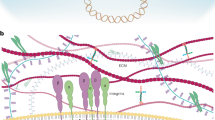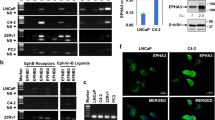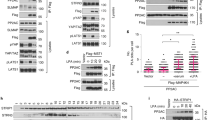Abstract
The Salvador/Warts/Hippo (Hippo) signaling pathway defines a novel signaling cascade regulating cell contact inhibition, organ size control, cell growth, proliferation, apoptosis and cancer development in mammals. The upstream regulation of this pathway has been less well defined than the core kinase cassette. KIBRA has been shown to function as an upstream member of the Hippo pathway by influencing the phosphorylation of LATS and YAP, but functional consequences of these biochemical changes have not been previously addressed. We show that in MCF10A cells, loss of KIBRA expression displays epithelial-to-mesenchymal transition (EMT) features, which are concomitant with decreased LATS and YAP phosphorylation, but not MST1/2. In addition, ectopic KIBRA expression antagonizes YAP via the serine 127 phosphorylation site and we show that KIBRA, Willin and Merlin differentially regulate genes controlled by YAP. Finally, reduced KIBRA expression in primary breast cancer specimens correlates with the recently described claudin-low subtype, an aggressive sub-group with EMT features and a poor prognosis.
This is a preview of subscription content, access via your institution
Access options
Subscribe to this journal
Receive 50 print issues and online access
$259.00 per year
only $5.18 per issue
Buy this article
- Purchase on Springer Link
- Instant access to full article PDF
Prices may be subject to local taxes which are calculated during checkout






Similar content being viewed by others
References
Zeng Q, Hong W . The emerging role of the hippo pathway in cell contact inhibition, organ size control, and cancer development in mammals. Cancer Cell 2008; 13: 188–192.
Edgar BA . From cell structure to transcription: Hippo forges a new path. Cell 2006; 124: 267–273.
Harvey K, Tapon N . The Salvador-Warts-Hippo pathway—an emerging tumour-suppressor network. Nat Rev Cancer 2007; 7: 182–191.
Harvey KF, Pfleger CM, Hariharan IK . The Drosophila Mst ortholog, hippo, restricts growth and cell proliferation and promotes apoptosis. Cell 2003; 114: 457–467.
Huang J, Wu S, Barrera J, Matthews K, Pan D . The Hippo signaling pathway coordinately regulates cell proliferation and apoptosis by inactivating Yorkie, the Drosophila Homolog of YAP. Cell 2005; 122: 421–434.
Pan D . Hippo signaling in organ size control. Genes Dev 2007; 21: 886–897.
Tapon N, Harvey KF, Bell DW, Wahrer DC, Schiripo TA, Haber DA et al. salvador Promotes both cell cycle exit and apoptosis in Drosophila and is mutated in human cancer cell lines. Cell 2002; 110: 467–478.
Hamaratoglu F, Willecke M, Kango-Singh M, Nolo R, Hyun E, Tao C et al. The tumour-suppressor genes NF2/Merlin and Expanded act through Hippo signalling to regulate cell proliferation and apoptosis. Nat Cell Biol 2006; 8: 27–36.
Genevet A, Wehr MC, Brain R, Thompson BJ, Tapon N . Kibra is a regulator of the Salvador/Warts/Hippo signaling network. Dev Cell 2010; 18: 300–308.
Yu J, Zheng Y, Dong J, Klusza S, Deng WM, Pan D . Kibra functions as a tumor suppressor protein that regulates Hippo signaling in conjunction with Merlin and Expanded. Dev Cell 2010; 18: 288–299.
Grusche FA, Richardson HE, Harvey KF . Upstream regulation of the hippo size control pathway. Curr Biol 2010; 20: R574–582.
Baumgartner R, Poernbacher I, Buser N, Hafen E, Stocker H . The WW domain protein Kibra acts upstream of Hippo in Drosophila. Dev Cell 2010; 18: 309–316.
Pellock BJ, Buff E, White K, Hariharan IK . The Drosophila tumor suppressors Expanded and Merlin differentially regulate cell cycle exit, apoptosis, and Wingless signaling. Dev Biol 2007; 304: 102–115.
Saburi S, Hester I, Fischer E, Pontoglio M, Eremina V, Gessler M et al. Loss of Fat4 disrupts PCP signaling and oriented cell division and leads to cystic kidney disease. Nat Genet 2008; 40: 1010–1015.
Mao Y, Mulvaney J, Zakaria S, Yu T, Morgan KM, Allen S et al. Characterization of a Dchs1 mutant mouse reveals requirements for Dchs1-Fat4 signaling during mammalian development. Development 2011; 138: 947–957.
Angus L, Moleirinho S, Herron L, Sinha A, Zhang X, Niestrata M et al. Willin/FRMD6 expression activates the Hippo signaling pathway kinases in mammals and antagonizes oncogenic YAP. Oncogene 2012; 31: 238–250.
Kremerskothen J, Plaas C, Buther K, Finger I, Veltel S, Matanis T et al. Characterization of KIBRA, a novel WW domain-containing protein. Biochem Biophys Res Commun 2003; 300: 862–867.
Papassotiropoulos A, Stephan DA, Huentelman MJ, Hoerndli FJ, Craig DW, Pearson JV et al. Common Kibra alleles are associated with human memory performance. Science 2006; 314: 475–478.
Bates TC, Price JF, Harris SE, Marioni RE, Fowkes FG, Stewart MC et al. Association of KIBRA and memory. Neurosci Lett 2009; 458: 140–143.
Schaper K, Kolsch H, Popp J, Wagner M, Jessen F . KIBRA gene variants are associated with episodic memory in healthy elderly. Neurobiol Aging 2008; 29: 1123–1125.
Corneveaux JJ, Liang WS, Reiman EM, Webster JA, Myers AJ, Zismann VL et al. Evidence for an association between KIBRA and late-onset Alzheimer’s disease. Neurobiol Aging 2010; 31: 901–909.
Hilton HN, Stanford PM, Harris J, Oakes SR, Kaplan W, Daly RJ et al. KIBRA interacts with discoidin domain receptor 1 to modulate collagen-induced signalling. Biochim Biophys Acta 2008; 1783: 383–393.
Xiao L, Chen Y, Ji M, Dong J . KIBRA regulates Hippo signaling activity via interactions with large tumor suppressor kinases. J Biol Chem 2011; 286: 7788–7796.
Creighton CJ, Li X, Landis M, Dixon JM, Neumeister VM, Sjolund A et al. Residual breast cancers after conventional therapy display mesenchymal as well as tumor-initiating features. Proc Natl Acad Sci USA 2009; 106: 13820–13825.
Hennessy BT, Gonzalez-Angulo AM, Stemke-Hale K, Gilcrease MZ, Krishnamurthy S, Lee JS et al. Characterization of a naturally occurring breast cancer subset enriched in epithelial-to-mesenchymal transition and stem cell characteristics. Cancer Res 2009; 69: 4116–4124.
Herschkowitz JI, Zhao W, Zhang M, Usary J, Murrow G, Edwards D et al. Comparative oncogenomics identifies breast tumors enriched in functional tumor-initiating cells. Proc Natl Acad Sci USA 2012; 109: 2778–2783.
Prat A, Parker JS, Karginova O, Fan C, Livasy C, Herschkowitz JI et al. Phenotypic and molecular characterization of the claudin-low intrinsic subtype of breast cancer. Breast Cancer Res 2010; 12: R68.
Overholtzer M, Zhang J, Smolen GA, Muir B, Li W, Sgroi DC et al. Transforming properties of YAP, a candidate oncogene on the chromosome 11q22 amplicon. Proc Natl Acad Sci USA 2006; 103: 12405–12410.
Zhang J, Smolen GA, Haber DA . Negative regulation of YAP by LATS1 underscores evolutionary conservation of the Drosophila Hippo pathway. Cancer Res 2008; 68: 2789–2794.
Praskova M, Xia F, Avruch J . MOBKL1A/MOBKL1B phosphorylation by MST1 and MST2 inhibits cell proliferation. Curr Biol 2008; 18: 311–321.
Hao Y, Chun A, Cheung K, Rashidi B, Yang X . Tumor suppressor LATS1 is a negative regulator of oncogene YAP. J Biol Chem 2008; 283: 5496–5509.
Chen DT, Nasir A, Culhane A, Venkataramu C, Fulp W, Rubio R et al. Proliferative genes dominate malignancy-risk gene signature in histologically-normal breast tissue. Breast Cancer Res Treat 2010; 119: 335–346.
Zhang N, Bai H, David KK, Dong J, Zheng Y, Cai J et al. The Merlin/NF2 tumor suppressor functions through the YAP oncoprotein to regulate tissue homeostasis in mammals. Dev Cell 2010; 19: 27–38.
Zhou D, Conrad C, Xia F, Park JS, Payer B, Yin Y et al. Mst1 and Mst2 maintain hepatocyte quiescence and suppress hepatocellular carcinoma development through inactivation of the Yap1 oncogene. Cancer Cell 2009; 16: 425–438.
Board R, Jayson GC . Platelet-derived growth factor receptor (PDGFR): a target for anticancer therapeutics. Drug Resist Updat 2005; 8: 75–83.
Eswarakumar VP, Lax I, Schlessinger J . Cellular signaling by fibroblast growth factor receptors. Cytokine Growth Factor Rev 2005; 16: 139–149.
Furuse M, Fujita K, Hiiragi T, Fujimoto K, Tsukita S . Claudin-1 and -2: novel integral membrane proteins localizing at tight junctions with no sequence similarity to occludin. J Cell Biol 1998; 141: 1539–1550.
Sarrio D, Rodriguez-Pinilla SM, Hardisson D, Cano A, Moreno-Bueno G, Palacios J . Epithelial-mesenchymal transition in breast cancer relates to the basal-like phenotype. Cancer Res 2008; 68: 989–997.
Mani SA, Guo W, Liao MJ, Eaton EN, Ayyanan A, Zhou AY et al. The epithelial-mesenchymal transition generates cells with properties of stem cells. Cell 2008; 133: 704–715.
Hong JH, Hwang ES, McManus MT, Amsterdam A, Tian Y, Kalmukova R et al. TAZ, a transcriptional modulator of mesenchymal stem cell differentiation. Science 2005; 309: 1074–1078.
Lian I, Kim J, Okazawa H, Zhao J, Zhao B, Yu J et al. The role of YAP transcription coactivator in regulating stem cell self-renewal and differentiation. Genes Dev 2010; 24: 1106–1118.
Cordenonsi M, Zanconato F, Azzolin L, Forcato M, Rosato A, Frasson C et al. The Hippo transducer TAZ confers cancer stem cell-related traits on breast cancer cells. Cell 2011; 147: 759–772.
Chan SW, Lim CJ, Guo K, Ng CP, Lee I, Hunziker W et al. A role for TAZ in migration, invasion, and tumorigenesis of breast cancer cells. Cancer Res 2008; 68: 2592–2598.
Debnath J, Muthuswamy SK, Brugge JS . Morphogenesis and oncogenesis of MCF-10A mammary epithelial acini grown in three-dimensional basement membrane cultures. Methods 2003; 30: 256–268.
Johnson KC, Kissil JL, Fry JL, Jacks T . Cellular transformation by a FERM domain mutant of the Nf2 tumor suppressor gene. Oncogene 2002; 21: 5990–5997.
Dai M, Wang P, Boyd AD, Kostov G, Athey B, Jones EG et al. Evolving gene/transcript definitions significantly alter the interpretation of GeneChip data. Nucleic Acids Res 2005; 33: e175.
Irizarry RA, Bolstad BM, Collin F, Cope LM, Hobbs B, Speed TP . Summaries of Affymetrix GeneChip probe level data. Nucleic Acids Res 2003; 31: e15.
Johnson WE, Li C, Rabinovic A . Adjusting batch effects in microarray expression data using empirical Bayes methods. Biostatistics 2007; 8: 118–127.
Sims AH, Smethurst GJ, Hey Y, Okoniewski MJ, Pepper SD, Howell A et al. The removal of multiplicative, systematic bias allows integration of breast cancer gene expression datasets—improving meta-analysis and prediction of prognosis. BMC Med Genomics 2008; 1: 42.
Eisen MB, Spellman PT, Brown PO, Botstein D . Cluster analysis and display of genome-wide expression patterns. Proc Natl Acad Sci USA 1998; 95: 14863–14868.
Acknowledgements
We are very grateful to Dr Avruch for providing the MOBKL1A/B antibody and to Dr Takeichi for providing the Willin antibody. We thank V Fedele and E Campbell for technical assistance. We also thank the Scottish University Life Science Alliance for funding for SM and Breakthrough Breast Cancer for funding for AHS and DF. CJO was funded by The National Health and Medical Research Council of Australia, New South Wales Cancer Council, Cancer Institute New South Wales, Banque Nationale de Paris-Paribas Australia and New Zealand, RT Hall Trust, Australian Cancer Research Foundation and the National Breast Cancer Foundation.
Author information
Authors and Affiliations
Corresponding authors
Ethics declarations
Competing interests
The authors declare no conflict of interest.
Additional information
Supplementary Information accompanies the paper on the Oncogene website
Supplementary information
Rights and permissions
About this article
Cite this article
Moleirinho, S., Chang, N., Sims, A. et al. KIBRA exhibits MST-independent functional regulation of the Hippo signaling pathway in mammals. Oncogene 32, 1821–1830 (2013). https://doi.org/10.1038/onc.2012.196
Received:
Revised:
Accepted:
Published:
Issue Date:
DOI: https://doi.org/10.1038/onc.2012.196
Keywords
This article is cited by
-
The Hippo signaling pathway contributes to the 2,5-Hexadion-induced apoptosis of ovarian granulosa cells
Journal of Ovarian Research (2023)
-
Suspension state and shear stress enhance breast tumor cells EMT through YAP by microRNA-29b
Cell Biology and Toxicology (2023)
-
MYC sensitises cells to apoptosis by driving energetic demand
Nature Communications (2022)
-
A proximity proteomics screen in three-dimensional spheroid cultures identifies novel regulators of lumen formation
Scientific Reports (2021)
-
Expression and regulation of FRMD6 in mouse DRG neurons and spinal cord after nerve injury
Scientific Reports (2020)



